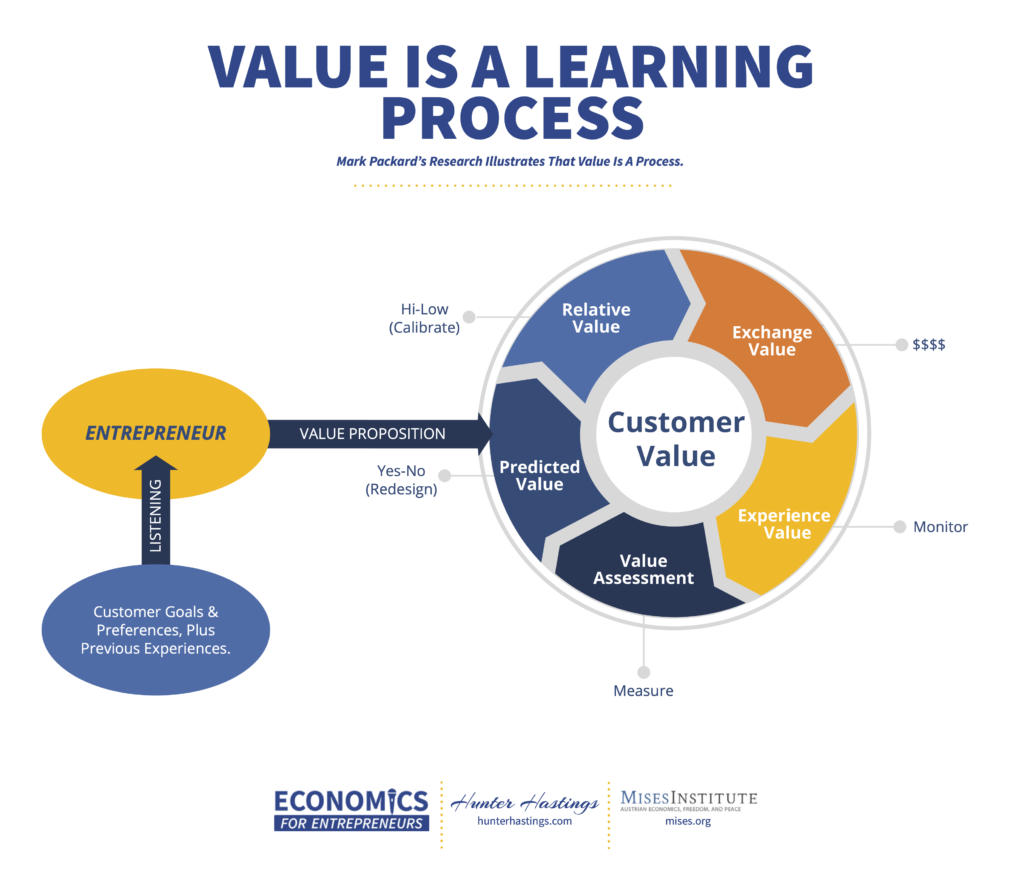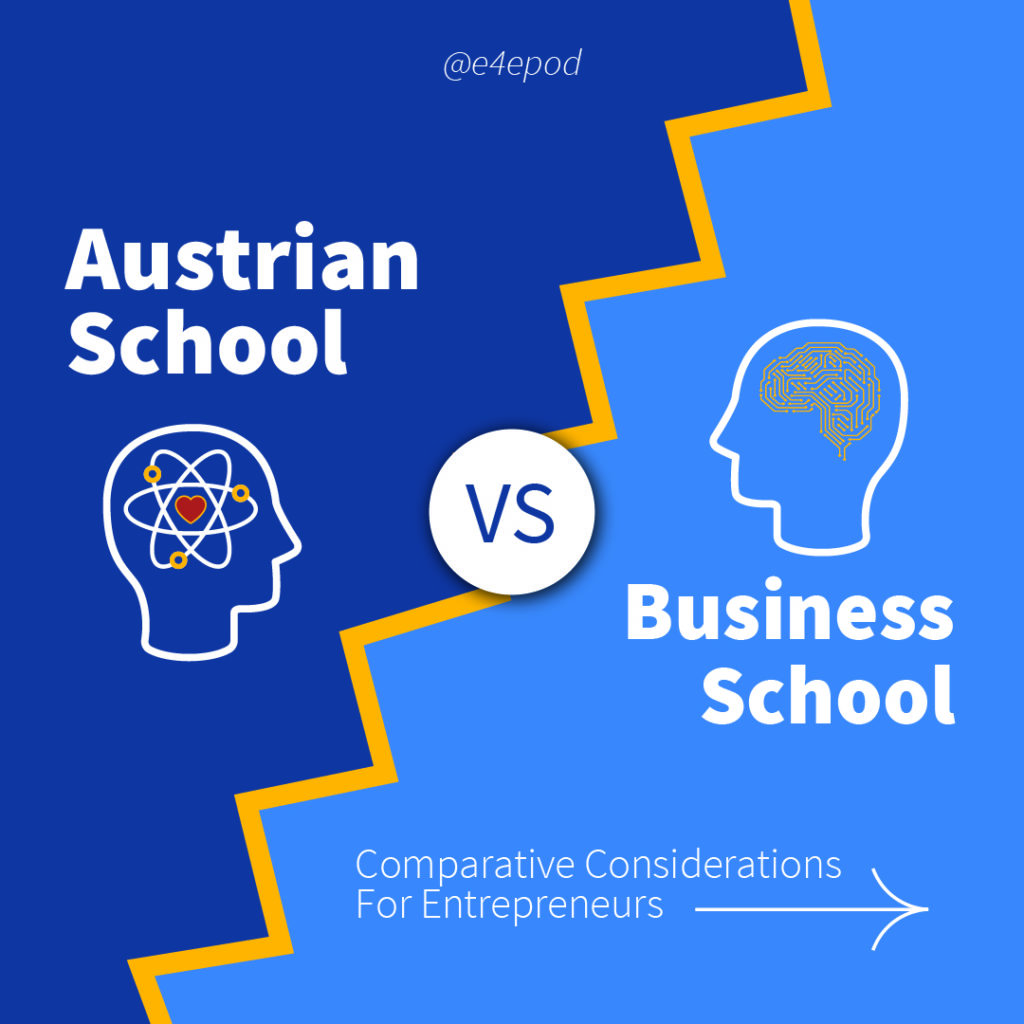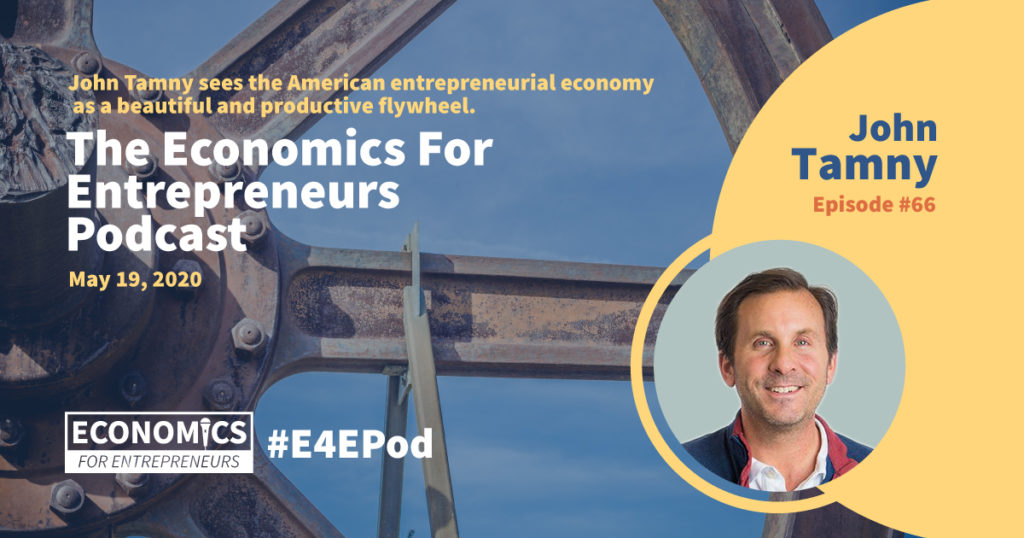Value
The purpose of any business is to generate value for customers. It’s important to understand what value is before taking on the task of generating it. Getting the understanding wrong can result in fatal mistakes in the value generation process.
Subjective Value
Value is subjective. It’s entirely in the mind of the customer. They’re the evaluator, and what’s valuable is what they feel is valuable. Value is a feeling.
Here lies one of the greatest challenges for business. A feeling is hard to measure, and can’t be quantified, whether in dollars or units. It can sometimes be calculated in relative terms – more value versus less value – but never in absolute terms.
How, then, should business approach the generation of a subjective quality?
Value errors
As a consequence of the challenge of understanding and measuring subjective value, business makes the error of defining value in terms that they believe can be legitimately quantified and therefore pursued as objectives.
Subjective value is customer value. The customer is the only value recipient that’s relevant to business. Management writer Peter Drucker said that the purpose of a business is to create and retain customers, and that goal is attained by creating customer value. All other positive outcomes for a firm – revenue, profits, growth, reputation – will follow from the pursuit of that purpose. Any deviation from the single-minded pursuit of customer value is guaranteed to be detrimental to long term outcomes. Nevertheless, business leaders, advisors, consultants, and economists have often recommended an alternative focus.
Shareholder Value
Economist Milton Friedman is the one accused of making shareholder value the central purpose of business. In the 1970’s, he wrote that managers should “conduct the business in accordance with [shareholders’] desires, which generally will be to make as much money as possible”. According to Chicago Booth Review, the business magazine from Friedman’s own university, his statement laid the foundations for the “shareholder value” revolution and the dominance of this interpretation of how businesses should be managed.
The metric employed for this goal is usually total shareholder returns (TSR), an aggregation of stock price appreciation plus dividends paid out to shareholders. There’s nothing related to customers in the calculation of total shareholder returns. At best, there could be some correlation – firms who serve their customers better might be expected to generate superior shareholder returns. But there is so much financial engineering in TSR (such as the use of stock buybacks and the dominance of institutional buyers in the movement of stock prices) that the correlation is by no means substantial. TSR is one of the metrics that can get capitalism a bad name.
Stakeholder value
Stakeholder value is the terminology that is applied to the idea that firms have a responsibility to create value for a broad swath of societal groupings including government, communities, climate and the biosystem, investors, suppliers, employees, and customers.
The stakeholder value movement often tries also to invoke sustainability (in the context of climate change) and social responsibility (in the context of social justice).
There are many reasons to repudiate the concept of pursuing multi-stakeholder value for business. First is the danger of establishing a confusing and impossible-to-reach set of goals, causing uncertainty and disequilibrium among employees and all the partners in the value system. Which goals are more important than others, and what trade-offs are the right ones to make? If customer value is sacrificed in order to better attain one of the other goals in the stakeholder set, will customers continue to buy? Will the firm survive?
Of course, the Austrian answer is that customers will determine the right balance of a firm’s activities. If customers prefer firms that support climate change goals over others, then those firms will win in the marketplace. Customers can send the message that their determination of subjective value includes the climate credentials of the firms they buy from. If that’s the case, then the pursuit of customer value is the only focus the firm needs. The same applies for all other stakeholder interests.
Value As A (Learning) Process
The feeling of value derives from experience. And, since experience is a process, that makes value a process. It’s not captured in a transaction (although it includes transactions), and it’s not captured in consumption (although it includes consumption). It’s a complete process embedded in an endless dynamic loop.
Stage 1: Predicted Value
When customers encounter a value proposition – in the form of an ad, or a Google search, or a recommendation, or a news item – they trigger an immediate subjective value assessment: is there the possibility of new value in this for me? At this stage, it’s a binary judgment, Yes-No. If yes, investigate further. If no, discard.
The task of business at this stage is to make a value proposition that gets noticed, and to trigger a positive prediction on the customer’s part that there might be some value for them.
Stage 2: Relative Value
Customers have no way to calculate value in any absolute terms, but they can – and in fact must – calculate relative value. Should I buy this or that? If I make this choice, then I can’t make a different choice or choose something else. What if I do nothing, would I be better off? Value can be a comparison in the customer’s mind. Economists call this value comparison “opportunity cost”. Every choice involves discounting the opportunity to take the opposite action.
For businesses making a value proposition to a customer, the task is to know what the customer is comparing to your proposition and the criteria they use to make the comparison.
Stage 3: Exchange value
Every economic transaction is an exchange. It usually takes the form of products or services for money, but also for time and effort and social risk (what will people think of me if I make this purchase?) Customers make the exchange value calculation in their minds. Businesses need to understand the terms of the calculation and make efforts to balance it in favor of their proposition through lower cost, greater convenience, faster speed, higher emotional reward, and any other weighting they can add on their favor.
Stage 4: Experience Value
Having made the exchange, the customer experiences the benefit via consumption, which may be over a short or extended period of time. They lick the ice cream cone they purchased, or they install the router or software system, or drive the car, or participate in the online course to which they subscribed. Every consumption is an experience. Business’s task is not completed when the exchange is made. It’s necessary to monitor the experience to make sure it’s going well, and to be a participant in situations where that is appropriate.
Stage 5: Value Assessment
At some point, the customer takes a mental step back to subjectively assess their experience. Did it meet their expectations? Did the relative value calculation they made hold up or did it turn out to be wrong in some way? Given any new value propositions coming their way, would they make a different choice in the future? Or does their assessment encourage them to make a repeat purchase, or take out a subscription or become a brand loyalist?
Business’s job at this stage is to make sure that feedback loops are in place to monitor the assessment that the customer is making, and to make sure it is heard, listened to, and fed to the right parts of the firm to trigger the appropriate response.
The value experience process is never ending. It never stops. Business must be geared for this endless cycle.
The Value Proposition

The customer’s value learning cycle is stimulated into action by value propositions. A value proposition can take the form of product or service design, or a sales pitch, or an advertisement, or a recommendation, or any format in which the customer can perceive a suggestion of potential future value.
Behind the customer-visible form of the value proposition is a formula that a business uses to translate future value they imagine for the customer into a value promise that the customer can respond to today.
The formula has 6 components:
FOR (a specific group of customers): A value proposition is for a specific set of customers, whom the business has defined with precision in order to be able to reach them with the proposition. The customer definition includes demographics (like age, education, income, geographic location), behavior (where do they shop, what do they buy, what are their activities, what websites do they visit, what content do they read and watch, where do they travel etc etc – the information available from big data streams and pattern analysis) and psychographics (how do they feel, what are their values, what are their emotional characteristics, what annoys them or disappoints them or makes them dissatisfied, what makes them happy).
WHO feel an identifiable dissatisfaction: What’s the identifiable value gap that this target group experiences that the brand or business is proposing to address? Businesses and brands don’t propose to make customers’ lives better in a general sense, but in the detailed sense of addressing a particular discontent or disappointment that customers feel right now.
BRAND: The value promise must come from a brand with which the customer can identify, incorporating a reputation and potential for trust.
VALUE PROMISE: The brand makes the promise to the customer to make life better. The promise must be highly specified so that the customer forms the right value expectation.
VALUE RATIONALE: The brand must set out a credible reason for the customer to believe that the promise will be delivered.
BENEFIT > COST: The value proposition must enable the customer to make the mental calculation that the benefit or reward of accepting the value proposition will be greater than the opportunity cost of foregoing other alternatives (including, for example, other things that could be acquired with the money to be given up in the exchange).
Perfecting these 6 elements of the value proposition establishes not only the basis for customer commerce, but also has the power to align all parts of the business with fulfilling the customer’s need.
Value Uniqueness
By employing the value learning process and the value proposition design template, businesses can achieve the goal of value uniqueness. By identifying target customers with great precision and developing a deep understanding of their current dissatisfactions, it’s possible to design and create a value proposition that’s unmatched and unmatchable by other firms. The value goal is not to compete to win the customer’s business but to match a value proposition to their need profile with uncontested exactness.
Value Agility
Since the value cycle never ends, neither does the business task of value generation. The value monitoring process will reveal changes in the customer’s context, in the range of offerings they consider, and in their personal and individual desires. The value generating firm is agile and adaptive, always willing and eager to change their proposition when customers change their preferences. Constant change is the norm to which value generating firms aspire.
The Value Centric Approach Of Austrian Economics.
The Austrian concept of subjective value is not just economic theory reserved for the classroom or the textbook. It’s the foundation for competitive advantage in business.
Customer-first: Businesses that place customer value in primary position among all their considerations for resource allocation, R&D investment, capital investment and organizational design will achieve greater market success than those that erroneously focus on value errors such as shareholder value maximization or stakeholder value.
Innovation: A subjective value focus illuminates the pathway to successful and profitable innovation. What will please the customer in the future? What kinds of experiences will they expect? How will their context change and how can new products and services best fit in? By taking the subjective value approach and starting at the customer and their wants and preferences, innovation projects can better chart the route to success.
Communication: Investments in advertising, PR and other forms of communication are to make customers aware of value propositions – the value the business is promising to customers. The subjective value approach to communication focuses on the right benefits – how will the proposition make customers feel – as opposed to a list of features and benefits more typical of product-centric communications.
Capital Investment: Capital is valuable only as a reflection of the customer value it enables in the future, through the production process. Every capital investment can be evaluated through this lens. What is the capital value of an office building that doesn’t contribute to customer value compared to a factory that does? These customer value trade-offs are value calculations that can be made every day in the customer-centered firm?
Organization: Organizational structure, divisions, business units and teams can be evaluated the same way as capital. How much do they contribute to subjective value for customers?







Is the concept of experience value the same as the concept of utility?
To Niklas Grube – is subject value the same as utility? Not quite. Utility can be defined objectively. What’s useful? An entrepreneur might produce something that is objectively useful, but the consumer does not perceive the subjective value in it. If I manufacture a bicycle, it has utility. But a consumer might not want it because they prefer another brand, or they don’t like the color it’s painted. When neo-classical economists talk of utility maximization as a driver of consumer behavior, they are defining utility objectively (because something subjective can’t be maximized – that’s a mathematical operation).
Thank you for your reply. I am still a bit confused regarding the Value Learning Cycle, though. I try to apply the subjectivist approach to a brand management framework, and I am having difficulties with different definitions of value.
At the moment I am reading ‘Principles of Economics’ by Menger. If my understanding is correct, for a good to be valuable, it has to have subjective utility (‘Nützlichkeit’), which basically means the capability of satisfaction of specific needs.
Value, then, is the subjective meaning the good has for an individual’s satisfaction of needs and is always related to a specific quantity of the good. Therefore, air usually has utility but no value because the total quantity of air exceeds the quantity needed for the satisfaction of all related needs. So, a specific unit of air has no value, since the related need would also be satisfied if it vanished. It has no meaning regarding the attainment of needs satisfaction.
Regarding the Value Learning Cycle, isn’t ‘Experience Value’ really the experienced utility (benefit via consumption) of a unit of a good (which would also apply to the experience of breathing air, which is not valuable), while the Value Assessment is the actual experienced value? This would matter, for example, for brand image, which can facilitate a satisfaction experience but is not necessarily valuable to consumers on its own because an image is not scarce.
Hi, Niklas,
I believe brand thinking is a useful and clarifying perspective for understanding subjective value. My early exposure to branding was in household cleaners and detergents. They are commodity chemicals that have high levels of perceived utility for some consumers in certain contexts – they can be used to give surfaces and fabrics a (perceived) cleanliness where cleanliness is scarce (it’s an unmet need). The benefit for the consumer transcends utility to become value because a higher emotional rather than functional goal applies. The consumer aspired to be (in American terminology) “a good mom”. She could associate our brand with the feeling of keeping a good household, which provided a valuable service to her family and was perceived by others as a meritorious achievement. Being a good mom is a scarce economic good, but it’s not utility, it’s subjectively perceived value.
One way to depict this is as a ladder or a values stack. The highest value (being a good mom) is the ultimate pursuit of the consumer. She may ascend to the top via the ladder rungs of features and attributes of the good and functional benefits (utility), but it is the highest value that is most important to her. A valued brand finds the strongest route to the top – the most salient functional benefits that ladder up to the highest value.
The Mengerian means-ends structure lies behind this. Here is a link to our means-ends tool.
https://hunterhastings.com/wp-content/uploads/2019/02/Means-End-Chain-2.pdf
Thank you, Hunter, for your insightful reply. The explanation and practical example is very valuable to me, and I think I understand the difference better now.